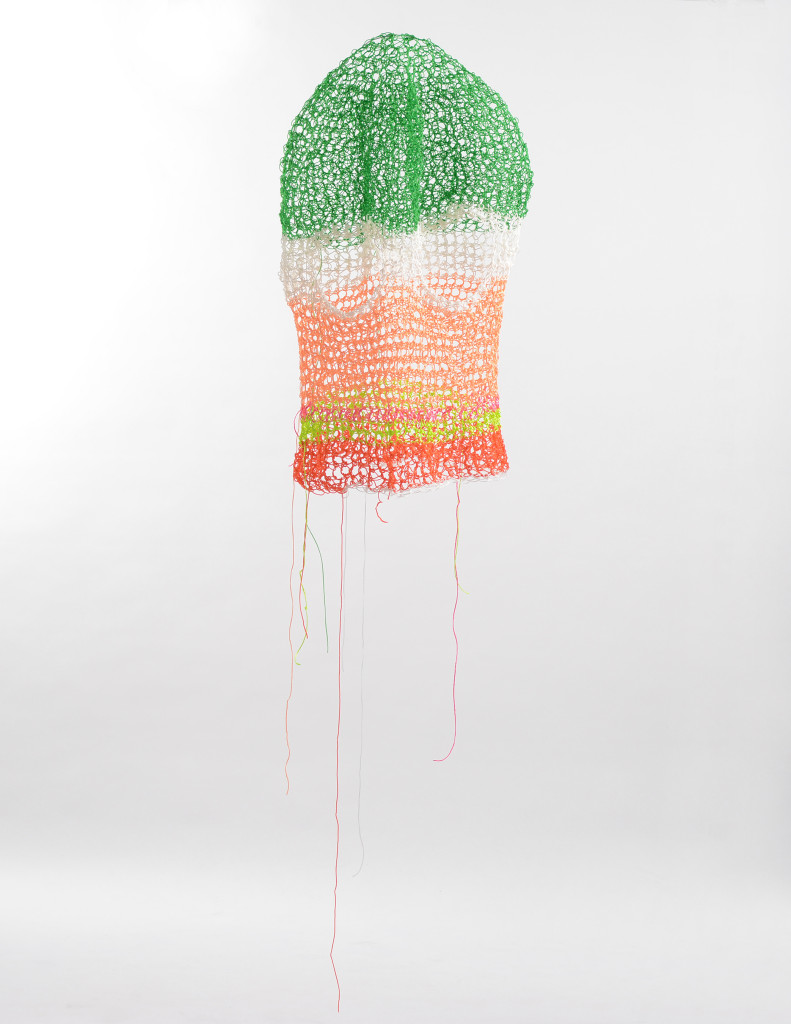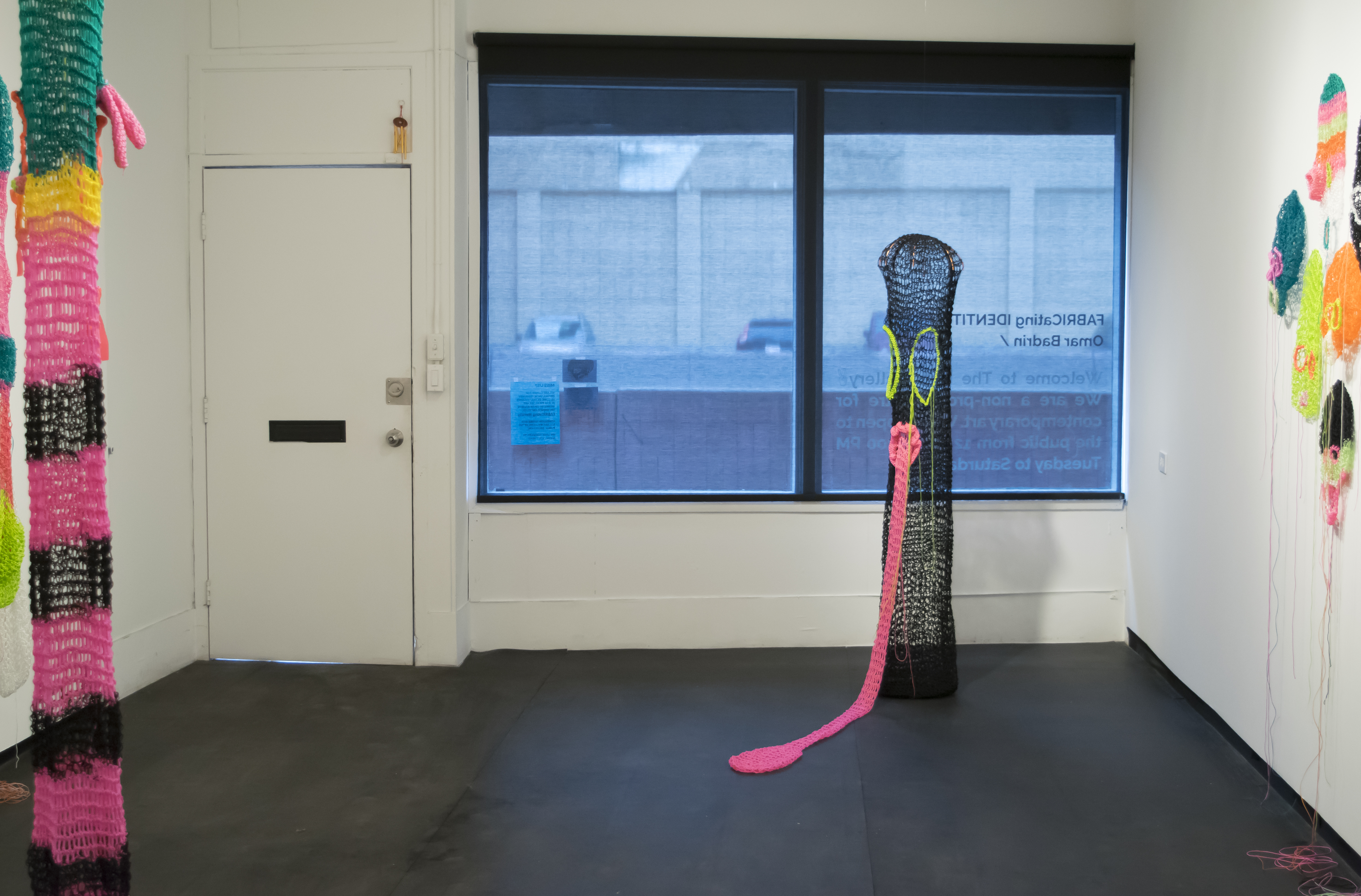MAINSPACE EXHIBITION /


FABRICating Identity
Omar Badrin
February 19 – March 26, 2016
FABRICating Identity is an exhibition of works by Omar Badrin. His practice has consistently revolved around the construction of identity. More recently, he has started to look at the topic through the lens of transracial adoption. Badrin’s work explores the racial and cultural dynamics of his personal upbringing as a visual minority who was born in Malaysia, adopted by a white parent, and raised in the mostly racially homogenous province of Newfoundland.
The materials and medium that Badrin explores are meant to signify cultural and family traditions. While the industrial fishing twines used in his work reflect his adopted culture, Badrin’s use of the medium of crochet is not only a signifier for the province but also of family history: at first, the use of crochet was a way of trying to fit in and belong within Newfoundland culture. However, upon reflection and after accepting that he would never feel like he belonged, his approach changed. Badrin began to make grotesque masks that reveal rather than hide the feelings of Otherness he felt from growing up in a place where he did not look like the people who surrounded him.







Omar Badrin’s Masks
Nothing of him that doth fade,
But doth suffer a sea-change
Into something rich and strange.
William Shakespeare. The Tempest.
It is intriguing that we seem drawn to masks. From the Lone Ranger to Darth Vader, from Venice’s Masquerade Ball to the masked terrorists of ISIS, the mask beckons to us, flirts with us, challenges us to recognize the paradox of our own identity. Paradoxes can be fun; identity, however, rarely is. Identity is a prison; identity is death.
Which brings us to Omar Badrin’s masks. Developed from a particular type – those used by skiers and terrorists – these masks appear to speak the sound of silence. Like flayed corpses with gaping mouths, they hang before us like a dread reminder of life’s tragically brief encounter.
But hold on! Are they not crocheted in pleasant pinks and yellows, purples and pastel greens? And come to think of it, Deflated seems more like a sad clown than an existential nightmare. I Dies at He seems a candidate for The Simpsons. What are we to make of such a paradox?
The question of an artist’s own experience, their biography, is always a touchy subject. We are torn as to whether we should read the work through their history, or our own; to read the work as propositions we can apply, or as a narrative to enjoy. Omar Badrin’s history is as entertaining as it is illuminating, and since he quotes it we are obligated to consider it. Born in Malaysia to Malaysian parents, he was shortly after adopted by a Newfoundland couple who brought him back to be raised in the fishing-dominated community of the island. There, Badrin found himself within both a loving, female-centred home and an estranging white culture. Referring to his work, he says: “one might say that I am rejecting a culture that I have always felt rejected me. It can also be interpreted as abandonment, which results in a subconscious void.” Yet on the other hand, Badrin is also quick to point out the depth of his debt to that very culture – to its hands-on relationship to making and mending, the significance of repetitive action in the craft-based business of fishing and working with the sea, to the titles borrowed from Newfoundland speech. These conflicting factors are clearly evident in his masks – the crocheting that he learnt from his mother, the net-like materiality of the work, the warm pinks and purples of their hues. All wrapped up in masks that suggest the trace of death.
So what do we make of Death? Shakespeare’s ‘something rich and strange’, or – as Badrin hints – Lacan’s terrifying void of the Sublime experience bereft of articulation? What proposition can we apply ourselves in our confrontation with Badrin’s work? Perhaps one finds it in the first line of Shakespeare’s quote: Nothing of him that doth fade. For a moment these paradoxical masks suspend us wordlessly between horror and reassurance, between the mark of the void and the marks of the hand: between death and life.
— Ian Carr-Harris
Biography
Omar Badrin is an interdisciplinary artist born in Kuala Lumpur, Malaysia. His work stems from his upbringing in Newfoundland and focuses on cultural identity, as well as its construction and representation through the use of visual metaphors. Badrin recently completed his MFA at OCAD University, in Toronto, where he currently lives. His thesis work earned him the winning medal in Interdisciplinary Art, Media and Design at the OCADU 100th Anniversary Graduate Exhibition. Prior to that, he obtained his BFA at Sir Wilfred Grenfell College (now Grenfell Campus), Memorial University of Newfoundland (2001).
Ian Carr-Harris is an artist and professor emeritus in the Faculty of Art at OCAD University. His particular interest is in the gap between the words we use and the images we construct, the arc of connection that illuminates the objects in the world through which we move.
